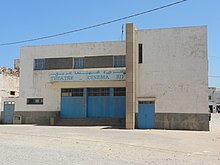| Cinema of Morocco | |
|---|---|
 Cinema Rif Essaouira | |
| No. of screens | 68 (2011)[1] |
| • Per capita | 0.2 per 100,000 (2011)[1] |
| Main distributors | Megarama Magreb Modern Films Younes[2] |
| Produced feature films (2011)[3] | |
| Fictional | 55 |
| Animated | - |
| Documentary | 1 |
| Number of admissions (2012)[5] | |
| Total | 2,011,294 |
| • Per capita | 0.08 (2010)[4] |
| National films | 681,341 (33.8%) |
| Gross box office (2012)[5] | |
| Total | MAD 69.2 million |
| National films | MAD 19.3 million (27.8%) |
| Cinema of Morocco |
|---|
  |
|
International Film Festival of Marrakech |
| Foreign movies shot in Morocco |
Cinema of Morocco (Arabic: السينما المغربية) refers to the film industry of Morocco. Aside from Arabic-language films, Moroccan cinema also produces Tamazight-language films.[6] The first film in Morocco was shot by Louis Lumière in 1897.[7] The first three Moroccan feature films were funded between 1968-1969.[8] Most researchers and critics agree that the history of Moroccan cinema started with Hamid Bénani's Wechma (1970), which is recognised as the first cult movie in Moroccan film history, and received critical acclaim on an international scale.[9][10] Until then films produced in the country were Moroccanised versions of Egyptian melodramas.[11] Other influential Moroccan films include A Thousand and One Hands, which was the first feature length fiction film of the 1970s.[12]
In 1982, Farida Bourquia became the first female Moroccan director, after her pioneering feature Al-Jamra.[13] In 2001, King Mohammed VI of Morocco created the Marrakech International Film Festival to promote and develop the art of cinema and the film industry in Morocco.[14] In 2018, the first Moroccan fantasy film, Achoura, was released.[15][16] Amazigh films, also known as Berber films, began to receive support by the Moroccan Cinematographic Center (CCM) in the mid-2000s; an example is Tamazight Oufella.[17]
In what has been described as a "vibrant new era" of Arab cinema, the 2020s has seen some stability in the Moroccan film industry.[18] In 2022, the first Moroccan animated films and animated series were produced.[19] In 2023, Moroccan cinema saw record-breaking production numbers, box office hits, and new infrastructure, partly due to the CCM's support and investments in upgrading and digitizing theaters. Moroccan cinema saw a dramatic surge in foreign investments, with 1.14 billion dirhams flowing into Moroccan film productions. Despite the success of local cinema and the national film scene, Hollywood dominated the market share, as opposed to French, Indian, and Egyptian films which accounted for less than 11% of the market by year's end.[20]
- ^ a b "Table 8: Cinema Infrastructure - Capacity". UNESCO Institute for Statistics. Archived from the original on 5 November 2013. Retrieved 5 November 2013.
- ^ "Table 6: Share of Top 3 distributors (Excel)". UNESCO Institute for Statistics. Archived from the original on 24 December 2018. Retrieved 5 November 2013.
- ^ "Table 1: Feature Film Production - Genre/Method of Shooting". UNESCO Institute for Statistics. Archived from the original on 24 December 2018. Retrieved 5 November 2013.
- ^ "Country profile: 2. Morocco" (PDF). Euromed Audiovisual. p. 114. Archived from the original (PDF) on 3 March 2016. Retrieved 14 November 2013.
- ^ a b "Bilan cinematographique 2012" (PDF). Centre Cinématographique Marocain. Retrieved 14 November 2013.
- ^ Ginsberg, Terri; Lippard, Chris (15 September 2020). Historical Dictionary of Middle Eastern Cinema. Rowman & Littlefield. ISBN 978-1-5381-3905-9.
- ^ "Meet the Boulanes". 4 April 2017.
- ^ Shafik, Viola (18 October 2022). Documentary Filmmaking in the Middle East and North Africa. American University in Cairo Press. ISBN 978-1-64903-035-1.
- ^ "A History of Moroccan Cinema".
- ^ Shafik, Viola (18 October 2022). Documentary Filmmaking in the Middle East and North Africa. American University in Cairo Press. ISBN 978-1-64903-035-1.
- ^ "A History of Moroccan Cinema".
- ^ Shafik, Viola (18 October 2022). Documentary Filmmaking in the Middle East and North Africa. American University in Cairo Press. ISBN 978-1-64903-035-1.
- ^ Armes, Roy (6 January 2018). Roots of the New Arab Film. Indiana University Press. ISBN 978-0-253-03173-0.
- ^ https://marrakech-festival.com/en/the-festival/
- ^ "فيلم خيال علمي.. السلهامي يطرح "عاشوراء ليلة الأطفال" بقاعات السينما (فيديو)". 8 October 2022.
- ^ "Arab and African Filmmakers Are Increasingly Focusing on Genre Films and Series". 8 December 2019.
- ^ Ginsberg, Terri; Lippard, Chris (15 September 2020). Historical Dictionary of Middle Eastern Cinema. Rowman & Littlefield. ISBN 978-1-5381-3905-9.
- ^ "Cannes: Is Arab Cinema on the Cusp of a "New Golden Age"?". The Hollywood Reporter. 17 May 2023.
- ^ "Africanews | Morocco: First animated films produced to honour cultural heritage". 13 August 2024.
- ^ "Morocco Unveils National Box Office for 2023".